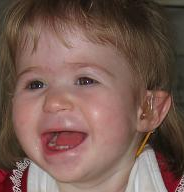1p36 Deletion Syndrome

1p36 deletion syndrome is a chromosomal anomaly characterized by distinctive facial dysmorphic features, hypotonia, developmental delay, intellectual disability, seizures, heart defects, hearing impairment and prenatal onset growth deficiency.
Epidemiology
1p36 deletion syndrome is considered one of the most common chromosome deletion syndromes, with an incidence of 1/ 5,000 to 1 /10,000 live births occurring equally in both genders, across all ethnicities.
Clinical description
Patients share recognizable craniofacial dysmorphism with straight eyebrows, deep-set eyes, broad and flat nasal root/bridge, midface hypoplasia, long philtrum, pointed chin, and frequently observed large late-closing anterior fontanel (>3 cm at birth), microbrachycephaly and posteriorly rotated, low-set, abnormal ears. Brachydactyly, camptodactyly and short feet are also characteristic. Almost all patients suffer from congenital hypotonia, contributing to feeding difficulties, delay in motor development and fine motor skills, and delayed or absent speech. A variable level of intellectual deficit is observed in all patients. Other symptoms include prenatal-onset growth deficiency, structural brain abnormalities, seizures, congenital heart defects, eye/vision problems, hearing loss (sensorineural or conductive/glue ear), skeletal anomalies, abnormalities of the external genitalia, and less frequent renal abnormalities and hypothyroidism.
Etiology
1p36 deletion syndrome is caused by a partial heterozygous deletion of mostly the distal part of the short arm of chromosome 1, with breakpoints ranging from 1p36.13 to 1p36.33. About 50% of cases are due to a de novo terminal 1p36 deletion, around 29% to an interstitial deletion; remaining cases comprise more complex chromosome rearrangements.
Diagnostic methods
Diagnosis is based on the clinical picture and is confirmed by chromosomal analysis. Molecular techniques are used for the genetic characterization of the deletion (FISH, CGH array). An evaluation for congenital heart defects with an echocardiogram and EKG; brain abnormalities with an MRI; seizures with an electroencephalogram; a neurodevelopmental assessment, and standard examination for eye/vision problems, hearing loss, and skeletal and renal abnormalities are recommended.
Differential diagnosis
Differential diagnosis includes Rett syndrome, Angelman syndrome and Prader-Willi syndrome (see these terms).
Antenatal diagnosis
In case of family history, prenatal testing is possible by amniocentesis or chorionic villus sampling and cytogenetic analyses. For couples in which one parent is a known carrier, preimplantation genetic diagnosis is available.
Genetic counseling
Genetic counseling is recommended to inform parents of the risk of recurrence in case they carry a balanced rearrangement involving 1p36.
Management and treatment
Management should be multi-disciplinary and include a regular follow-up. Early diagnosis and access to personalized rehabilitation therapies focusing on motor development, cognition, communication, and social skills are highly recommended. The use of sign language is helpful. Some congenital heart defects may resolve on their own, others may require medication or surgery. Epileptic seizures are treated with standard antiepileptics. Infantile spasms are responsive to corticotrophin. Feeding and growth should be monitored as feeding difficulties are common early on. Triiodothyronine, thyroxine, and thyrotropin levels should be evaluated at diagnosis, and, then, once a year.
Prognosis
The severity of the 1p36 deletion syndrome varies between affected individuals. Seizures and other medical issues seem to improve with time. Patients will remain dependent of others for most activities of daily living and will require medical support throughout life. Individuals with 1p36 deletion syndrome survive well into adult life.